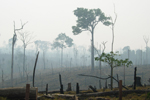
A parasitic wasp attacks an aphid in the first study to prove the theory that the extinction of one predator can lead to the extinction of another. Photo by: Dirk Sanders.
A new study in Biology Letters demonstrates that altering the relationship between a predator and its prey can cause wide-ranging ripple effects through an ecosystem, including unexpected extinctions.
Species help each other, directly or indirectly, which scientists refer to as mutualism or commensalism. For example, a species’ success may rely not only upon the survival of its food source, but may also indirectly rely upon the survival of more distantly related species.
To study the connections between species, ecologists and students from the University of Exeter’s Centre for Ecology and Conservation conducted a lab experiment which analyzed how the extinction of a single predator wasp species impacted its neighbors.
“Our experiment provides the first proof of something that biologists have argued for a long time: predators can have indirect effects on each other, to the extent that when one species is lost, the loss of these indirect effects can lead to further extinctions,” said lead author Dr Frank van Veen, in a press release.
 Relationships between predatory wasps, aphids, and food plant. Graph courtesy of Sanders et al. |
The study of five interrelated species confirms that ecosystems are structured more like webs than chains. Ecologists created laboratory model ecosystems assembled from the Sutton (Vicia faba) plants as a shared resource for the herbivorous Scopoli aphids (Aphis fabae) and the Harris aphids (Acyrthosiphon pisum), as well as their carnivorous parasitoid wasp predators: the Marshall wasp (Lysiphlebus fabarum) and the Haliday wasp (Aphidius ervi), each of which attacks only one of the aphid species.
Research involved the mock extinction of the Haliday wasp, which exclusively feeds on the Harris aphid. The experiment was conducted in seven replicates over eight weeks, and in each case, the removal of the Haliday wasp resulted in the cascading extinctions of other species.
The Harris aphid, no longer controlled by its Haliday wasp predator, saw its population boom and was soon outcompeting the Scopoli aphid for access to its food plant, the Sutton. The stiff competition between aphids eventually pushed the Scopoli aphid into extinction, which in turn led to the extinction of its main predator, the Marshall parasitoid wasp.
In other words, the extinction of the first wasp resulted in the loss of two other species through a sequence of direct and indirect domino-like effects.
The study illustrates the need to anticipate the secondary effects of extinction when trying to prevent biodiversity loss. To effectively save species a finer appreciation of the complex network of relationships within ecosystems is needed. The authors argue in their paper that additional ecosystem-wide research is needed to appreciate more fully how species relate to and affect each other, sometimes unpredictably.
“Although our study focused on insects, the principle would be the same for predators in any ecosystem, ranging from big cats on the African plains to fish in our seas,” van Veen says. “Our research highlights the fact that a ‘single species’ approach to conservation can be ineffective and even counter-productive.”
CITATION: Dirk Sanders and F. J. Frank van Veen. Indirect commensalism promotes persistence of secondary consumer species. Biology Letters. 2012.
Related articles
Japan declares its river otter extinct
(08/28/2012) Japan’s Ministry of the Environment today declared the Japanese river otter (Lutra lutra whiteleyi) extinct. Last seen in 1979 in the city of Susaki on the island of Shikoku, the unique subspecies was killed-off by overhunting and loss of habitat due to development.
North American freshwater fish going extinct at rate over 800 times the fossil record
(08/14/2012) Since 1898 North America has lost at least 39 species of freshwater fish, according to a new study in Bioscience, and an additional 18 subspecies. Moreover, the loss of freshwater fish on the continent seems to be increasing, as the rate jumped by 25 percent since 1989, though even this data may be low.
Climate change may be worsening impacts of killer frog disease
(08/13/2012) Climate change, which is spawning more extreme temperatures variations worldwide, may be worsening the effects of a devastating fungal disease on the world’s amphibians, according to new research published in Nature Climate Change. Researchers found that frogs infected with the disease, known as chytridiomycosis, perished more rapidly when temperatures swung wildly. However scientists told the BBC that more research is needed before any definitive link between climate change and chytridiomycosis mortalities could be made.
Still time to save most species in the Brazilian Amazon

(07/12/2012) Once habitat is lost or degraded, a species doesn’t just wink out of existence: it takes time, often several generations, before a species vanishes for good. A new study in Science investigates this process, called “extinction debt”, in the Brazilian Amazon and finds that 80-90 percent of the predicted extinctions of birds, amphibians, and mammals have not yet occurred. But, unless urgent action is taken, the debt will be collected, and these species will vanish for good in the next few decades.
Meet the world’s rarest snake: only 18 left
-(Large).150.jpg)
(07/10/2012) It’s slithery, brown, and doesn’t mind being picked up: meet the Saint Lucia racer (Liophis ornatus), which holds the dubious honor of being the world’s most endangered snake. A five month extensive survey found just 18 animals on a small islet off of the Caribbean Island of Saint Lucia. The snake had once been abundant on Saint Lucia, as well, but was decimated by invasive mongooses. For nearly 40 years the snake was thought to be extinct until in 1973 a single snake was found on the Maria Major Island, a 12-hectare (30 acre) protected islet, a mile off the coast of Saint Lucia (see map below).













